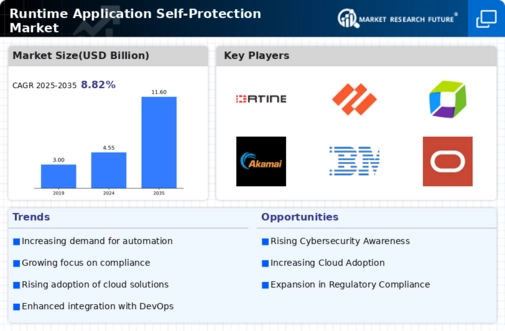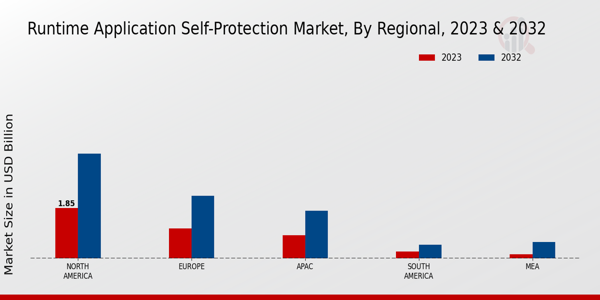Market Growth Projections
The Global Runtime Application Self-Protection Market Industry is projected to experience substantial growth over the coming years. With a market value of 4.55 USD Billion in 2024, it is expected to reach 11.6 USD Billion by 2035, reflecting a robust CAGR of 8.88% from 2025 to 2035. This growth trajectory is indicative of the increasing recognition of the importance of runtime application self-protection in safeguarding applications against evolving cyber threats. As organizations continue to prioritize security investments, the market is likely to expand, driven by technological advancements and the need for compliance with regulatory standards.
Increasing Cybersecurity Threats
The Global Runtime Application Self-Protection Market Industry is experiencing heightened demand due to the increasing frequency and sophistication of cyber threats. Organizations are compelled to adopt advanced security measures to protect sensitive data and applications. For instance, the rise in ransomware attacks has prompted businesses to invest in runtime application self-protection solutions. This trend is reflected in the projected market growth, with estimates indicating a market value of 4.55 USD Billion in 2024, escalating to 11.6 USD Billion by 2035. Such figures underscore the urgency for robust security frameworks in an evolving threat landscape.
Adoption of Cloud-Based Solutions
The Global Runtime Application Self-Protection Market Industry is witnessing a surge in the adoption of cloud-based solutions, which inherently require robust security measures. As businesses migrate to cloud environments, the need for runtime application self-protection becomes paramount to safeguard applications from potential vulnerabilities. The flexibility and scalability offered by cloud solutions further drive this trend, as organizations seek to enhance their security posture without compromising performance. This shift is anticipated to contribute significantly to the market's growth trajectory, aligning with the overall increase in cloud adoption across industries.
Regulatory Compliance Requirements
The Global Runtime Application Self-Protection Market Industry is significantly influenced by stringent regulatory compliance requirements across various sectors. Governments and regulatory bodies are increasingly mandating organizations to implement comprehensive security measures to safeguard personal and financial information. For example, regulations such as GDPR and PCI DSS necessitate the adoption of runtime application self-protection technologies. This compliance-driven approach not only mitigates risks but also enhances consumer trust. As organizations strive to meet these regulations, the market is expected to grow at a CAGR of 8.88% from 2025 to 2035, reflecting the critical role of compliance in shaping security investments.
Integration of AI and Machine Learning
The Global Runtime Application Self-Protection Market Industry is increasingly benefiting from the integration of artificial intelligence and machine learning technologies. These advanced tools enhance the ability of runtime application self-protection solutions to detect and respond to threats in real-time. By analyzing patterns and anomalies, AI-driven systems can proactively identify vulnerabilities and mitigate risks before they escalate. This technological advancement not only improves security efficacy but also streamlines operational processes. As organizations recognize the value of AI in enhancing application security, the market is poised for substantial growth, driven by innovation and technological advancements.
Growing Awareness of Application Security
The Global Runtime Application Self-Protection Market Industry is experiencing growth fueled by a heightened awareness of application security among organizations. As businesses increasingly recognize the critical role of applications in their operations, there is a corresponding emphasis on securing these assets. Educational initiatives and industry collaborations are fostering a culture of security awareness, prompting organizations to invest in runtime application self-protection solutions. This trend is likely to accelerate market growth, as organizations prioritize security in their digital transformation strategies, ensuring that applications remain resilient against emerging threats.
























Leave a Comment